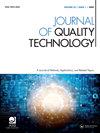Complex geometries in additive manufacturing: A new solution for lattice structure modeling and monitoring
IF 2.6
2区 工程技术
Q2 ENGINEERING, INDUSTRIAL
引用次数: 10
Abstract
Abstract The production of novel types of complex shapes is nowadays enabled by new manufacturing paradigms such as additive manufacturing, also known as 3D printing. The continuous increase of shape complexity imposes new challenges in terms of inspection, product qualification and process monitoring methodologies. Previously proposed methods for 2.5D free-form surfaces are no longer applicable in the presence of this kind of new full 3D geometries. This paper aims to tackle this challenge by presenting a statistical quality monitoring approach for structures that cannot be described in terms of parametric models. The goal consists of identifying out-of-control geometrical distortions by analyzing either local variations within the part or changes from part to part. The proposed approach involves an innovative solution for modeling the deviation between the nominal geometry (the originating 3D model) and the real geometry (measured via x-ray computed tomography) by slicing the shapes and estimating the deviation slice by slice. 3D deviation maps are then transformed into 1D deviation profiles enabling the use of a profile monitoring scheme for local defect detection. The feasibility and potential of this method are demonstrated by focusing on a category of complex shapes where an elemental geometry regularly repeats in space. These shapes are known as lattice structures, or metamaterials, and their trabecular shape is thought to provide innovative mechanical and functional performance. The performance of the proposed method is shown in real and simulated case studies.增材制造中的复杂几何:晶格结构建模和监测的新解决方案
如今,新型复杂形状的生产是由新的制造范式(如增材制造,也称为3D打印)实现的。形状复杂性的不断增加对检验、产品鉴定和过程监控方法提出了新的挑战。以前提出的2.5D自由曲面的方法不再适用于这种新的全三维几何形状。本文旨在通过提出一种不能用参数模型描述的结构的统计质量监测方法来解决这一挑战。目标包括通过分析零件内部的局部变化或零件之间的变化来识别失控的几何变形。所提出的方法涉及一种创新的解决方案,通过对形状进行切片并逐片估计偏差,来建模标称几何形状(原始3D模型)与实际几何形状(通过x射线计算机断层扫描测量)之间的偏差。然后将3D偏差图转换为1D偏差轮廓,从而可以使用轮廓监测方案进行局部缺陷检测。这种方法的可行性和潜力是通过集中在一个复杂的形状类别,其中一个基本的几何形状在空间中有规律地重复证明。这些形状被称为晶格结构或超材料,它们的小梁形状被认为提供了创新的机械和功能性能。实例分析和仿真结果表明了该方法的有效性。
本文章由计算机程序翻译,如有差异,请以英文原文为准。
求助全文
约1分钟内获得全文
求助全文
来源期刊

Journal of Quality Technology
管理科学-工程:工业
CiteScore
5.20
自引率
4.00%
发文量
23
审稿时长
>12 weeks
期刊介绍:
The objective of Journal of Quality Technology is to contribute to the technical advancement of the field of quality technology by publishing papers that emphasize the practical applicability of new techniques, instructive examples of the operation of existing techniques and results of historical researches. Expository, review, and tutorial papers are also acceptable if they are written in a style suitable for practicing engineers.
Sample our Mathematics & Statistics journals, sign in here to start your FREE access for 14 days
 求助内容:
求助内容: 应助结果提醒方式:
应助结果提醒方式:


